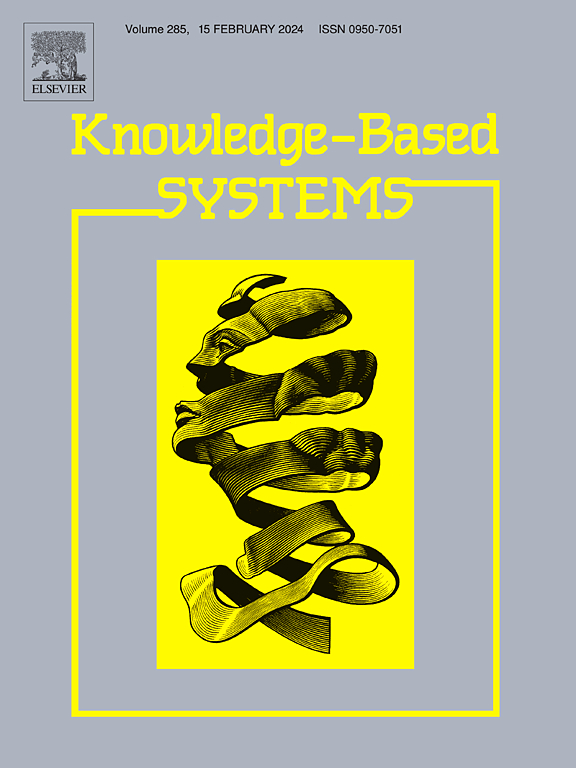多兴趣序列推荐的双空间多粒度模型
IF 7.2
1区 计算机科学
Q1 COMPUTER SCIENCE, ARTIFICIAL INTELLIGENCE
引用次数: 0
摘要
顺序推荐的目的是为给定历史交互顺序的用户预测下一个项目。近年来,多兴趣范式和基于图神经网络(GNN)的范式是研究此类任务的两个新方向。多兴趣学习包括通过历史项目聚类提取不同的用户兴趣,而GNN通过历史项目之间的相关性来提炼用户偏好。最近的研究表明,结合这些方法在多个层面上聚合用户偏好具有协同潜力,提高了多兴趣提取的准确性,从而改进了推荐。然而,现有的基于gnn的多兴趣模型只能通过邻居信息聚合实现节点嵌入的局部平滑,因此,即使这些远程项目表现出相似的局部模式,并且项目可能反映了一些小生境偏好,它们也无法匹配远程项目(项目-项目图上距离较远的项目)。在多兴趣推荐的背景下,这是不合理的,因为目标是更全面地捕捉用户的兴趣。为了解决这个问题,我们提出了一个双空间多粒度推荐模型(DSMGRec),其中设计了一个图反卷积网络(GDcN)来解开项目的局部基于结构的模式,作为它们的附加嵌入。然后,我们采用了一种结合传统GNN和我们的新GDcN的对偶框架来编码对偶空间中项目的多粒度表示。这种双项目表示不仅可以通过主要模式匹配项目,还可以通过次要模式匹配项目。在四个不同密度的真实世界数据集上的实验表明,我们的模型优于最先进的基线。本文章由计算机程序翻译,如有差异,请以英文原文为准。
Dual space multi-granular model for multi-interest sequential recommendation
Sequential recommendation aims to predict the next item for a user given his historical interaction sequence. Recently, multi-interest and Graph Neural Network (GNN) based paradigms are two new directions in such task. Multi-interest learning encompasses extracting diverse user interests through historical item clustering, while GNN refines user preferences through correlations among historical items. Recent research suggests the synergistic potential of combining these methods to aggregate user preferences at multiple levels, enhancing the accuracy of multi-interest extraction for improved recommendations. However, existing GNN-based multi-interest models can only achieve local smoothing for node embeddings through neighbor information aggregating, thus, they could not match remote items (far-apart items on the item–item graph) even though those remote items show similar local patterns and the items may reflect some niche preferences. It is unreasonable in the context of multi-interest recommendation as the objective is to capture the user’s interests in a more comprehensive manner. To tackle this issue, we propose a Dual Space Multi-Granular Recommendation model (DSMGRec), where a Graph Deconvolutional Network (GDcN) is designed to disentangle local structure-based patterns of items as their additional embeddings. Then, we adopt a dual framework that combines the traditional GNN with our novel GDcN to encode multi-granular representations for items in the dual space. Such dual item representations can match items by not only their primary patterns but also their secondary patterns. Experiments on four real-world datasets with different densities show that our model outperforms state-of-the-art baselines.
求助全文
通过发布文献求助,成功后即可免费获取论文全文。
去求助
来源期刊

Knowledge-Based Systems
工程技术-计算机:人工智能
CiteScore
14.80
自引率
12.50%
发文量
1245
审稿时长
7.8 months
期刊介绍:
Knowledge-Based Systems, an international and interdisciplinary journal in artificial intelligence, publishes original, innovative, and creative research results in the field. It focuses on knowledge-based and other artificial intelligence techniques-based systems. The journal aims to support human prediction and decision-making through data science and computation techniques, provide a balanced coverage of theory and practical study, and encourage the development and implementation of knowledge-based intelligence models, methods, systems, and software tools. Applications in business, government, education, engineering, and healthcare are emphasized.
 求助内容:
求助内容: 应助结果提醒方式:
应助结果提醒方式:


